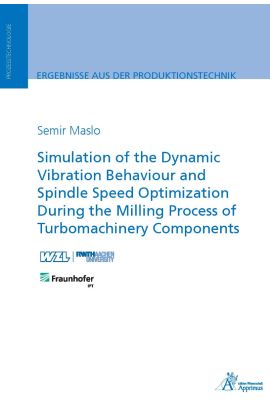Vibrations with large amplitudes could occur during the milling process of thin-walled workpieces for constant process parameters. These vibrations reduce the efficiency of the process and increase the manufacturing costs of components. At present, the selection of an advantageous spindle rotational frequency that leads to minimal vibration amplitudes is often done heuristically in the industry. In the milling of thin-walled workpieces, such as blisks, the process dynamics is highly dependent on the local workpiece dynamics in the cutter zone. The workpiece dynamics continuously varies during milling, due to the mass reduction caused by the material removal and the change of the tool position, which thereby leads to an excitation of the local mode shapes. This background provided the basis for formulating the main hypothesis of the present research: By taking into consideration the location- and time-dependent workpiece dynamics in the cutting zone, it is possible to simulate process vibrations and to adapt the spindle rotation frequency in a targeted manner in order to achieve a reduction in vibrations.
In this thesis, a methodology was developed to simulate the process dynamics, including the varying workpiece dynamics, measured tool dynamics, cutting force and regenerative effect. The present work is structured to address three main research questions, which were the driver of the developments. The first question is on how best to describe the transient workpiece dynamics, such that a location-dependent vibration simulation in the time-domain is enabled. The second question addresses how a systematic adaption of the spindle rotational frequency in the milling process can be realized to reach a process with minimal vibrations. The final question driving the research was whether the developed methodology is applicable for blisks with complex shaped blade geometries.
The result of this work is a stability diagram which makes it possible to identify advantageous spindle rotation frequencies with regard to the transient process dynamics. This stability diagram was validated by milling tests for a 3-axis and 5-axis milling process with different spindle rotation frequencies.
| Autor | Maslo, Semir |
|---|---|
| Gewicht | 0.274 kg |
| Erscheinungsdatum | 25.05.2022 |
Prozesstechnologie
Simulation of the Dynamic Vibration Behaviour and Spindle Speed Optimization During the Milling Process of Turbomachinery Components
Kurzbeschreibung
Thin-walled workpieces like blisks are challenging to mill as they are highly sensitive to process vibrations. These vibrations lower the process efficiency and can lead to damages on the workpiece surface and increased tool wear.
In this thesis a simulation methodology is shown, which enables the prediction of process vibrations with respect to the transient workpiece and tool dynamics. Based on the simulation model, advantageous process parameters are identified to reach an efficient process.

